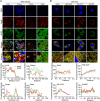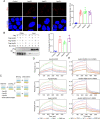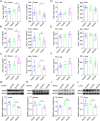ApoE4 associated with severe COVID-19 outcomes via downregulation of ACE2 and imbalanced RAS pathway
- PMID: 36759834
- PMCID: PMC9910247
- DOI: 10.1186/s12967-023-03945-7
ApoE4 associated with severe COVID-19 outcomes via downregulation of ACE2 and imbalanced RAS pathway
Abstract
Background: Recent numerous epidemiology and clinical association studies reported that ApoE polymorphism might be associated with the risk and severity of coronavirus disease 2019 (COVID-19), and yielded inconsistent results. Severe acute respiratory syndrome coronavirus 2 (SARS-CoV-2) infection relies on its spike protein binding to angiotensin-converting enzyme 2 (ACE2) receptor expressed on host cell membranes.
Methods: A meta-analysis was conducted to clarify the association between ApoE polymorphism and the risk and severity of COVID-19. Multiple protein interaction assays were utilized to investigate the potential molecular link between ApoE and the SARS-CoV-2 primary receptor ACE2, ApoE and spike protein. Immunoblotting and immunofluorescence staining methods were used to access the regulatory effect of different ApoE isoform on ACE2 protein expression.
Results: ApoE gene polymorphism (ε4 carrier genotypes VS non-ε4 carrier genotypes) is associated with the increased risk (P = 0.0003, OR = 1.44, 95% CI 1.18-1.76) and progression (P < 0.00001, OR = 1.85, 95% CI 1.50-2.28) of COVID-19. ApoE interacts with both ACE2 and the spike protein but did not show isoform-dependent binding effects. ApoE4 significantly downregulates ACE2 protein expression in vitro and in vivo and subsequently decreases the conversion of Ang II to Ang 1-7.
Conclusions: ApoE4 increases SARS-CoV-2 infectivity in a manner that may not depend on differential interactions with the spike protein or ACE2. Instead, ApoE4 downregulates ACE2 protein expression and subsequently the dysregulation of renin-angiotensin system (RAS) may provide explanation by which ApoE4 exacerbates COVID-19 disease.
Keywords: ACE2; ApoE4; COVID-19; SARS-CoV-2; Spike.
© 2023. The Author(s).
Conflict of interest statement
The authors declare no potential conflicts of interest.
Figures









Similar articles
-
APOE interacts with ACE2 inhibiting SARS-CoV-2 cellular entry and inflammation in COVID-19 patients.Signal Transduct Target Ther. 2022 Aug 1;7(1):261. doi: 10.1038/s41392-022-01118-4. Signal Transduct Target Ther. 2022. PMID: 35915083 Free PMC article.
-
In-silico modeling of the interplay between APOE4, NLRP3, and ACE2-SPIKE complex in neurodegeneration between Alzheimer and SARS-CoV: implications for understanding pathogenesis and developing therapeutic strategies.J Biomol Struct Dyn. 2024 Nov;42(18):9678-9690. doi: 10.1080/07391102.2023.2252094. Epub 2023 Aug 29. J Biomol Struct Dyn. 2024. PMID: 37643074
-
Spike-mediated ACE2 down-regulation was involved in the pathogenesis of SARS-CoV-2 infection.J Infect. 2022 Oct;85(4):418-427. doi: 10.1016/j.jinf.2022.06.030. Epub 2022 Jul 3. J Infect. 2022. PMID: 35793758 Free PMC article.
-
COVID-19: angiotensin-converting enzyme 2 (ACE2) expression and tissue susceptibility to SARS-CoV-2 infection.Eur J Clin Microbiol Infect Dis. 2021 May;40(5):905-919. doi: 10.1007/s10096-020-04138-6. Epub 2021 Jan 3. Eur J Clin Microbiol Infect Dis. 2021. PMID: 33389262 Free PMC article. Review.
-
Angiotensin-Converting Enzyme 2 (ACE2) in the Pathogenesis of ARDS in COVID-19.Front Immunol. 2021 Dec 22;12:732690. doi: 10.3389/fimmu.2021.732690. eCollection 2021. Front Immunol. 2021. PMID: 35003058 Free PMC article. Review.
Cited by
-
KGG: a fully automated workflow for creating disease-specific knowledge graphs.Bioinformatics. 2025 Jul 1;41(7):btaf383. doi: 10.1093/bioinformatics/btaf383. Bioinformatics. 2025. PMID: 40580451 Free PMC article.
-
Molecular cross-talk between long COVID-19 and Alzheimer's disease.Geroscience. 2024 Jun;46(3):2885-2899. doi: 10.1007/s11357-024-01096-1. Epub 2024 Feb 23. Geroscience. 2024. PMID: 38393535 Free PMC article. Review.
-
Vessel-on-a-Chip: A Powerful Tool for Investigating Endothelial COVID-19 Fingerprints.Cells. 2023 May 2;12(9):1297. doi: 10.3390/cells12091297. Cells. 2023. PMID: 37174696 Free PMC article. Review.
-
Blood ACE2 Protein Level Correlates with COVID-19 Severity.Int J Mol Sci. 2023 Sep 11;24(18):13957. doi: 10.3390/ijms241813957. Int J Mol Sci. 2023. PMID: 37762258 Free PMC article.
-
Sister haplotypes and recombination disequilibrium: a new approach to identify associations of haplotypes with complex diseases.Front Genet. 2024 Jan 16;14:1295327. doi: 10.3389/fgene.2023.1295327. eCollection 2023. Front Genet. 2024. PMID: 38292437 Free PMC article.
References
Publication types
MeSH terms
Substances
LinkOut - more resources
Full Text Sources
Medical
Miscellaneous

